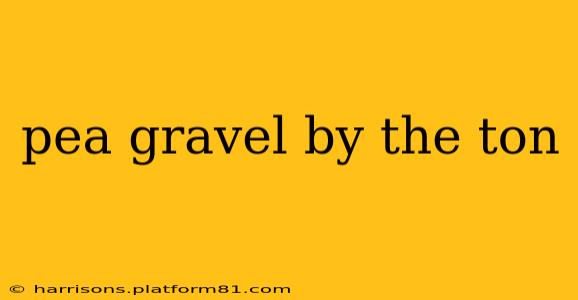Pea gravel, with its charmingly small, rounded stones, is a landscaping staple loved for its versatility and aesthetic appeal. But buying pea gravel by the ton can feel overwhelming if you're not sure what to expect. This comprehensive guide will cover everything you need to know, from understanding pricing to exploring its diverse applications. We'll also address common questions surrounding this popular landscaping material.
How Much Does Pea Gravel Cost Per Ton?
The price of pea gravel per ton varies significantly based on several factors:
- Location: Transportation costs play a huge role. Pea gravel sourced locally will generally be cheaper than material shipped long distances.
- Supplier: Different suppliers have different pricing structures, reflecting their operational costs and profit margins. Shopping around is crucial to finding the best deal.
- Type of Pea Gravel: While generally similar, variations in color (e.g., white, gray, brown) and the exact size of the stones can influence the price. Higher-quality, more uniformly sized gravel might command a premium.
- Quantity: Bulk purchases often come with discounts, making buying by the ton more economical than purchasing smaller quantities.
While providing an exact price is impossible without specifics, you can expect to pay anywhere from $30 to $70 per ton in many areas. Always contact local suppliers for accurate, up-to-date pricing in your region.
What Are the Different Uses for Pea Gravel?
Pea gravel's small size and smooth texture make it suitable for a wide range of applications:
- Driveways: It provides excellent drainage and a pleasing aesthetic, although it's not ideal for heavy traffic.
- Walkways: Pea gravel pathways offer a natural, textured surface, but they may require more maintenance than paved walkways.
- Landscaping: It's used extensively as a decorative mulch around plants, adding visual interest and helping to retain moisture.
- Water Features: Its smooth texture prevents damage to pond liners and looks beautiful in water gardens.
- French Drains: Pea gravel's excellent drainage properties make it perfect for directing water away from foundations.
How Much Pea Gravel Do I Need?
Calculating the amount of pea gravel needed depends entirely on the project's size and depth. To estimate:
- Measure the area: Calculate the square footage of the area you plan to cover.
- Determine the depth: How deep do you want the gravel layer to be (e.g., 2 inches, 4 inches)? Convert this to feet.
- Calculate the cubic volume: Multiply the square footage by the depth in feet.
- Convert to tons: One cubic yard of pea gravel typically weighs approximately one ton. Convert your cubic footage to cubic yards (divide by 27) to get an approximate tonnage.
This is just an estimate; it's always best to slightly overestimate to account for settling and potential waste.
What is the Best Way to Install Pea Gravel?
Proper installation ensures a long-lasting, attractive finish. Consider these steps:
- Prepare the area: Remove any existing vegetation, level the ground, and compact the soil. For driveways or walkways, consider adding a weed barrier fabric.
- Add a border (optional): This helps contain the gravel and prevents it from spreading.
- Spread the gravel: Evenly distribute the pea gravel to the desired depth.
- Compact (optional): For driveways or high-traffic areas, compact the gravel using a plate compactor.
What are the Pros and Cons of Using Pea Gravel?
Pros:
- Affordable: Generally less expensive than other landscaping materials.
- Versatile: Suitable for various applications.
- Drainage: Excellent drainage properties prevent waterlogging.
- Aesthetically pleasing: Adds a natural, attractive look.
Cons:
- Maintenance: May require occasional raking or replenishing.
- Weed control: Requires weed barrier fabric to prevent weed growth.
- Not suitable for heavy traffic: Not ideal for areas with significant vehicle traffic.
Is Pea Gravel the Same as River Rock?
While both are natural stones used in landscaping, pea gravel and river rock differ significantly in size and shape. Pea gravel consists of small, uniformly rounded stones, while river rock encompasses a wider range of sizes and shapes, often with flatter or more irregular surfaces.
Where Can I Buy Pea Gravel in Bulk?
Local landscaping supply yards, home improvement stores, and gravel quarries are excellent sources for purchasing pea gravel in bulk. Always compare prices and delivery options before committing to a purchase.
This guide provides a comprehensive overview of pea gravel by the ton. Remember to always consult with local suppliers for accurate pricing and to discuss your specific project needs. Happy landscaping!
